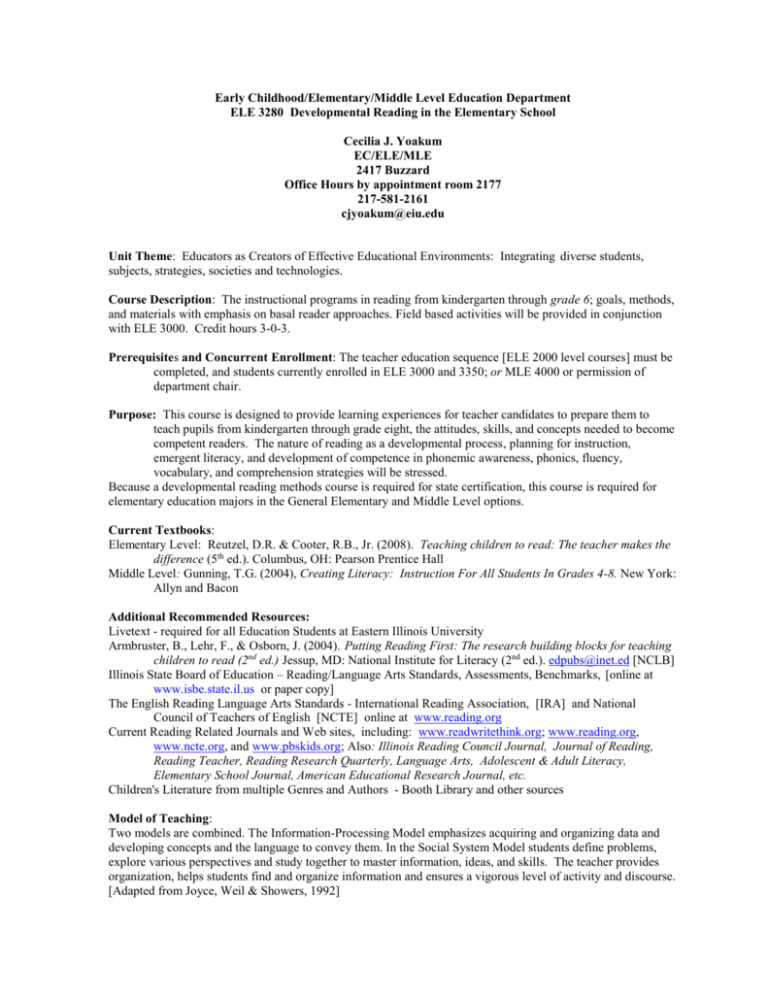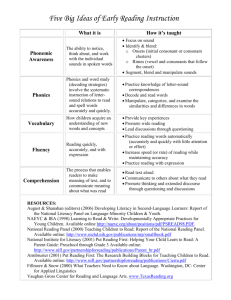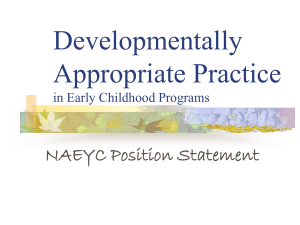
Early Childhood/Elementary/Middle Level Education Department
ELE 3280 Developmental Reading in the Elementary School
Cecilia J. Yoakum
EC/ELE/MLE
2417 Buzzard
Office Hours by appointment room 2177
217-581-2161
cjyoakum@eiu.edu
Unit Theme: Educators as Creators of Effective Educational Environments: Integrating diverse students,
subjects, strategies, societies and technologies.
Course Description: The instructional programs in reading from kindergarten through grade 6; goals, methods,
and materials with emphasis on basal reader approaches. Field based activities will be provided in conjunction
with ELE 3000. Credit hours 3-0-3.
Prerequisites and Concurrent Enrollment: The teacher education sequence [ELE 2000 level courses] must be
completed, and students currently enrolled in ELE 3000 and 3350; or MLE 4000 or permission of
department chair.
Purpose: This course is designed to provide learning experiences for teacher candidates to prepare them to
teach pupils from kindergarten through grade eight, the attitudes, skills, and concepts needed to become
competent readers. The nature of reading as a developmental process, planning for instruction,
emergent literacy, and development of competence in phonemic awareness, phonics, fluency,
vocabulary, and comprehension strategies will be stressed.
Because a developmental reading methods course is required for state certification, this course is required for
elementary education majors in the General Elementary and Middle Level options.
Current Textbooks:
Elementary Level: Reutzel, D.R. & Cooter, R.B., Jr. (2008). Teaching children to read: The teacher makes the
difference (5th ed.). Columbus, OH: Pearson Prentice Hall
Middle Level: Gunning, T.G. (2004), Creating Literacy: Instruction For All Students In Grades 4-8. New York:
Allyn and Bacon
Additional Recommended Resources:
Livetext - required for all Education Students at Eastern Illinois University
Armbruster, B., Lehr, F., & Osborn, J. (2004). Putting Reading First: The research building blocks for teaching
children to read (2nd ed.) Jessup, MD: National Institute for Literacy (2nd ed.). edpubs@inet.ed [NCLB]
Illinois State Board of Education – Reading/Language Arts Standards, Assessments, Benchmarks, [online at
www.isbe.state.il.us or paper copy]
The English Reading Language Arts Standards - International Reading Association, [IRA] and National
Council of Teachers of English [NCTE] online at www.reading.org
Current Reading Related Journals and Web sites, including: www.readwritethink.org; www.reading.org,
www.ncte.org, and www.pbskids.org; Also: Illinois Reading Council Journal, Journal of Reading,
Reading Teacher, Reading Research Quarterly, Language Arts, Adolescent & Adult Literacy,
Elementary School Journal, American Educational Research Journal, etc.
Children's Literature from multiple Genres and Authors - Booth Library and other sources
Model of Teaching:
Two models are combined. The Information-Processing Model emphasizes acquiring and organizing data and
developing concepts and the language to convey them. In the Social System Model students define problems,
explore various perspectives and study together to master information, ideas, and skills. The teacher provides
organization, helps students find and organize information and ensures a vigorous level of activity and discourse.
[Adapted from Joyce, Weil & Showers, 1992]
2
Dispositions: Teacher candidates in the Department of EC/ELE/MLE will exhibit professional ethical practices,
effective communication, sensitivity to diversity, and the ability to provide varied teaching practices
evidenced in a supportive and encouraging environment.
Standards:
Course requirements and demonstrated competencies are aligned with the following standards:
Association for Childhood Education International (ACEI)
http://www.acei.org/Synopsis.htm
National Association for the Education of Young Children (NAEYC)
http://www.naeyc.org/accreditation/next_era.asp
Illinois Professional Teaching Standards (IPTS)
http://www.isbe.il.us/profprep/PDFs/ipts.pdf
Illinois Core Language Arts Standards (ICLAS)
http://www.isbe.net/profprep/CASCDvr/pdfs/24110_corelangarts_std.pdf
Illinois Reading Teacher Standards
http://www.isbe.il.us/profprep
Illinois Core Technology Standards (ICTS)
http://www.isbe.net/profprep/CASCDvr?pdfs/24100_coretechnology.pdf
Teacher Candidates will:
1 demonstrate a mastery of the theories, concepts, facts, principles, ideas and relationships of reading
2 understand and describe reading as a developmental and cognitive process and design instruction to
further pupil development of those processes
3 comprehend the components of and develop learning activities for teaching phonemic awareness,
phonics, fluency, vocabulary and comprehension strategies
4 compare, contrast, and use multiple methods of teaching reading, including, but not limited to: basal
readers, teacher directed instruction [DRA/DRTA], reading workshop, guided reading, reciprocal
teaching, QAR--question-answer-response
5 select appropriate reading materials for various grade levels with consideration of student interest and
reading and readability levels, genres, and sources [online, books, magazines, environmental, etc.]
6 understand appropriate assessments of student reading ability
7 demonstrate knowledge of historical and current issues related to reading education including culturally and
linguistic diverse [CLD] learners
Standards:
ACEI:
1. Development, learning & motivation
2. Curriculum: 2.1 English language arts; 2.8 connections across the curriculum
3. Instruction
4. Assessment
5. Professionalism
NAEYC: 2 Family & Community Relations
4: Teaching and Learning [with emphasis on 4c – knowledge, 4d meaningful curriculum]
Illinois Professional Teaching Standards: [IPTS]
1. Content
7. Communication
3. Diversity
8. Assessment
4. Planning for instruction
10. Reflection and professional growth
5. Learning environment
11. Professional conduct
6. Instructional Delivery
Illinois Learning Standards [ILS] for Reading/Language Arts: 1, 2, 3, 4, 5 are met in this course. They
correlate closely with the Standards for the English Language Arts developed by the International
Reading Association/National Council of Teachers of English, thus both sets are met.
Illinois Reading Teacher Standards: The competent reading teacher--Standard 1: has deep understanding of reading and reading instruction
Standard 3: participates in curriculum design and implementation
Standard 5: has high professional standards--ethics, self-evaluation, professional memberships
3
Competencies and Standards Matrix
Course
Competencies to be Demonstrated by
Aligned to these Standards
Requirements
Pre-Service Teachers
[Abbreviations Above]
Comprehension of
Passing of exams with 85% or better accuracy
ACEI 1., 2.1, 2.8, 3
fundamentals of
Applications of knowledge in planning, presenting
NAEYC 4c, 4d
reading instruction
and modeling of reading lessons
IPTS 1, 3, 4, 6, 10
& current/past best
ICRLAS
practices methods
IRTS 1, 2
Design developCreate a literature file with DAP/CLD activities &
ACEI 2.1 2.8, 5
mentally [DAP] and children’s literature from various authors
NAEYC 2, 4c, 4d
culturally [CLD]
Prepare and present Directed Reading Thinking
ICRLAS
appropriate
Activity appropriate to the intended grade level of
IRTS 1, 3
Instruction to
students with attention to multiple intelligences
IPTS 1, 3, 4, 5, 6, 8, 10
further student
Participation in class and practicum lessons
ICTS 1,2,3,5,7,8
cognitive learning
Thoughtful evaluation of basals & reading programs
Comprehend and
Include components and assessment in modeling a
ACEI 1, 2, 3, 4, 5
teach the five core
children’s literature lesson & Directed Reading
NAEYC 4
components of
Thinking Lesson;
ICRLAS
reading education
Identify components taught & assessed in practicum
IRTS 1, 2, 3
and means for their
Evidence of comprehension and ability to apply on
IPTS 1, 3, 4, 5, 6, 8, 10
assessment
phonics test and other exams
ICTS
Compare and
Evaluate children’s literature as a means for teaching ACEI 1, 2, 3, 4, 5
contrast multiple
reading when readability and interests are considered NAEYC 4
methods for
Comparing and contrasting reading methods through ICRLAS
teaching/enabling
modeling; problem solving activities; sample
IRTS 1, 3
reading by grade
applications and observations of classroom teachers
IPTS 1, 3, 4, 6, 7, 8, 10, 11
levels
during practicum; by reading journals and
ICTS
recommended sample lessons; and through virtual
observations
Develop a basic
Select appropriate learning activities and texts for
ACEI 1, 2, 3, 4,
knowledge of
reading with consideration of readability levels and
NAEYC 2,
reading assessments appropriateness for ability levels, diverse prior
ICRLAS
valid for diverse
experiences and student interests.
IRTS
elementary age
Indicate understanding of the advantages and caveats IPTS 1, 3, 6, 7, 8,
students
of using observation, performance standards and
ICTS
standardized tests for assessing reading ability
Core Requirements and Grading Matrix
Core Requirements:
General Description of Assignments
~ %
Teacher Candidates will:
Grade
Literature Response
select children's books, review and summarize them; recommend
15%
File/ Book Cards
methods for incorporating them during the teaching of reading;
Directed Reading
design a directed reading/thinking lesson; model it in class; and submit
Activity [DRTA]
the written lesson plan for recording in Livetext; Plan should include
15%
Lesson
activities for before, during, & following the reading of text in
manageable segment
Test on Basic Phonics Terminology related to teaching of phonics and use of diacritical marks
15%
Basal Textbook or
Examination of student text book and teacher guides from a recent basal
10%
Reading Program
series, and/or review of a reading program used within a school during
Review
the practicum experience
Exam(s)
Examination(s) based on applicable terminology, concepts, &
30%
applications.
Teacher Selections
In class participation; Other items/adjustment of percents at teacher
15%
discretion and/or student needs
4
Grading Scale: A=100-92%; B=91-83%; C=82-74%; D=73-65%; F=below 65% [Livetext see below]
Livetext Departmental Policy Statement: If the Live Text requirements are rated, by the instructor, to have
been completed in less than a satisfactory manner then no more than a "D" may be earned in the class regardless
of the number of points earned.
Optional Assignments:
Genre project report and/or bulletin board;
Skill Lesson from Children’s Literature Book;
Extended responses to literature
Author Report
In class activities or short take home assignments based on individual or group needs
Language experience activity
Multicultural/diversity oriented literature experiences Differentiated instruction assignment
Course Topics [Not listed by weeks because of great variety as to practicum timing and experiences]
Integrated through out all Units:
Concern for cultural differences and similarities
Appropriate integration of children's literature
Flexible grouping to meet needs of all students
On-going assessment to guide future teaching
Application of educational psychology techniques for effective teaching and
learning
I. Nature of Reading Process
A. Reading as a language process
B. Reading theories: historical and current
1. bottom-up / top-down (phonics / whole word )
2. balanced reading (whole language, including phonics)
3. social interaction
4. transaction of text to reader
C. Relationship of reading with other language arts
II. Reading Readiness [Emergent Reading]
A. Nature of reading readiness
1. Physical
2. Cognitive
3. Experiential
B. Oral language/oracy as Basis for Reading
C. Alphabetic Principles
III. Requirements for Reading – NCLB--- What Is Required & Methods for Teaching
A. Cueing Systems –
1. grapho-phonemic
2. syntax
3. semantic
B. Phonemic Awareness
C. Phonics
1. Basic
2. Structural Analysis
3. Sight Words
D. Fluency
1. Automaticity
2. Rate
3. Prosadics [expression, melody]
E. Vocabulary development
5
1. Before reading, during reading, after reading
2. Experience oriented
3. Synonyms, antonyms
4. Multiple meaning words
F. Comprehension Strategies
1. Activate schema – prior experiences
2. Context clues
3. Selection of appropriate reading materials with consideration of
a. readability and reading levels
b. fiction, non-fiction, multiple genres
c. student interest and involvement
4. Structural analysis clues – affixes, root & base words
5. Metacognition
6. Predicting
7. Answering and asking questions – QAR; clarifying difficult words/concepts
8. Summarizing Using graphic and semantic organizers
9. Compare and contrast
IV. Teaching Methods for Classroom Effectiveness
A. Assessment as a guide to teaching
B. Basal Reading Programs
C. Teacher Directed Instruction
1. Directed Reading [Thinking] Activities
2. Guided Reading – with and without leveled books
D. Reading and Reading/Writing Workshops [4 blocks/5 blocks, Adaptations of Reading Recovery]
E. Reciprocal Teaching – predict, clarify, question, summarize
F. Effective use of flexible grouping specifically related to teaching of reading
References/Resources: [See previous listing of text and recommended online or journal references]
Allington. R.L. (2001). What really matters for stuggling readers: Designing research-based programs. New
York: Addison-Wesley Longman.
Bloom, B. (1956). Taxonomy of educational objectives. New York: David McKay.
Cambourne, B. (1988). The whole story: Natural learning and the acquisition of literacy in the classroom. New
York: Ashton-Scholastic.
Chenfeld, M. B. (1993). Teaching in the key of life. Washington, DC: NAEYC
Chomsky, N. ((1974) Aspects of the theory of syntax, (2nd ed.) Cambridge, MA: MIT Press.
Clay, M. (1998). By different paths to common outcomes. York: ME. Stenhouse.
Collins-Block, C., & Pressley, M. (2002), Comprehension instruction: Research-based best practices. New
York: Guilford Press.
Cunningham, P.M. (2005). Phonics they use: Words for reading and writing. Boston, MA: Allyn and Bacon.
Fountas, I.C. & Pinnell, G/S. (2001). Guiding readers and writers: Grades 3-6. Teaching comprehension,
genre, and content literacy. Portsmouth, NH: Heinemann.
Goodman, K.S. & Goodman, Y.M. (1983). Reading and writing relationships: Pragmatic functions. Language
Arts, 60(5), 590-599.
Piaget, J. (1955). The language and thought of the child. New York: World.
Routman, R. (2003). Reading essentials: The specifics you need to know to teach reading well. Portsmouth, NH:
Heinemann.
Vygotsky, L.S. (1990). Mind in society. Boston: Harvard University Press.
Yopp, H.K. (1992). Developing phonemic awareness in young children. The Reading Teacher, 45(9), 696-703.
6
Recommended Text Reading for ELE3280
Chapter 1 Effective Reading Instruction
Pages: 8-15, 16
Chapter 2 Developing Children’s Oral Language
Pages: 25-29, 33, 36-37, 67
Chapter 3 Early Reading Instruction
Pages: 72-75, 78-79, 82-95
Chapter 4 Phonics and Word Identification
Pages: 105-115, 131-139
Chapter 5 Developing Children’s Reading Fluency
Pages: 144-145, 150-160, 165-170, 174-175, 181-182
Chapter 6 Increasing Reading Vocabulary
Pages: 193, 195-199, 205, 207-211, 215-219, 223
Chapter 7 Teaching Reading Comprehension
Pages: 234, 240, 246-248, 262-263, 271, 274-275
Chapter 10 Programs ( ie: Basals) and Standards for Reading Instruction
Pages: 372-373, 378, 391, 394, 397-400
Chapter 12 Effective Reading Instruction and Organization in Grades 4-8
Pages: 46-463, 470-473
7
Assignments for ELE 3280
Assignments
Points
6 Literature File-Book Cards with one presentation
K/1, 2/3, 3/4, 5/6, 7/8
30
Lesson plan using Live Text format
Grade level: 1/2, 3/4, 5/6
30
Basal Review/Content Area
30
DRA Lesson Activity
5
Phonics Test
30
Bulletin Board Presentation
30
Short Answer/Multiple Choice in class assignments
Note: Assignments may not be made up without permission
30
Final Exam
50
Grading Scale:
92% to 100% =A
85% to 91% =B
75% to 84% =C
65% to 74%=D
Please Remember: Attendance and participation are very important. Please come to class to
complete assignments given in class. Please bring your textbook and handout packet to class for discussion.
I do take attendance. Missed work can not be emailed to me. To receive full credit for an assignment it must
be handed in during class on that day. If you need to miss class for a doctor, appt. or funeral please call me
@ 581-2161 or email me. If you have a disability or think you may have a disability under ADA contact the
Office of Disability Services @ 581-6583.






